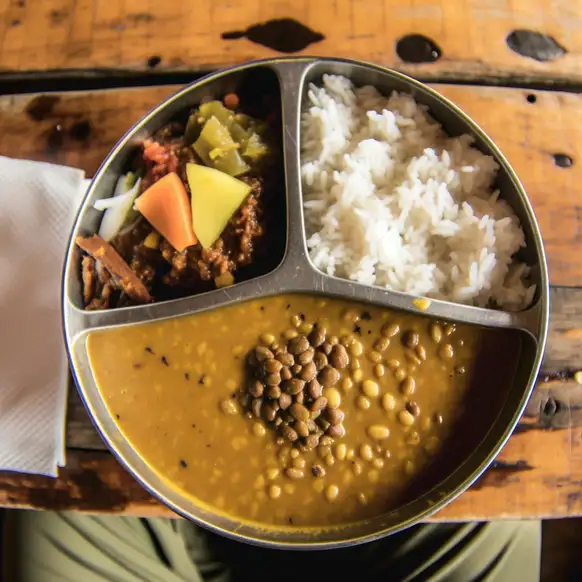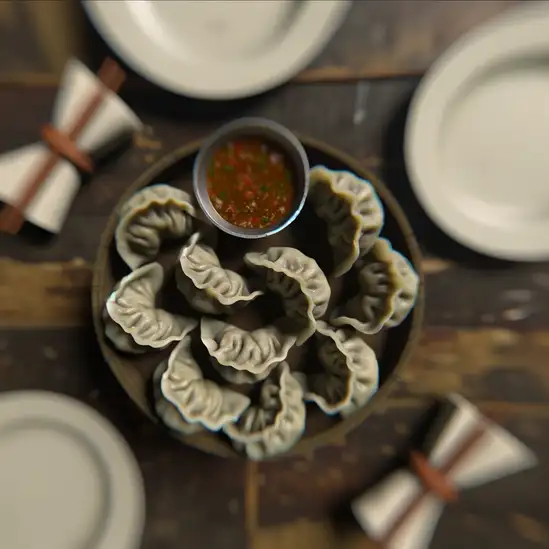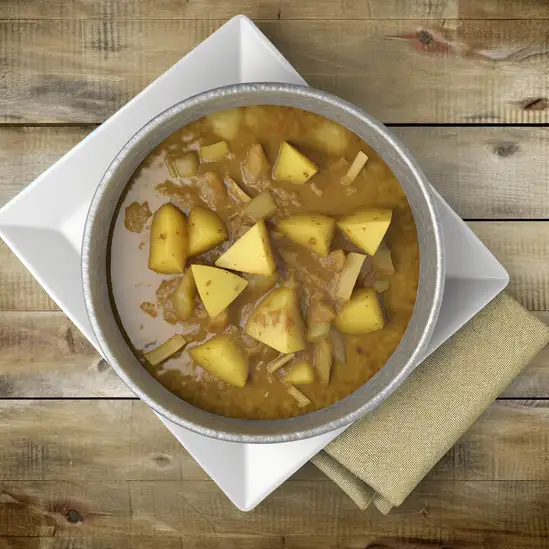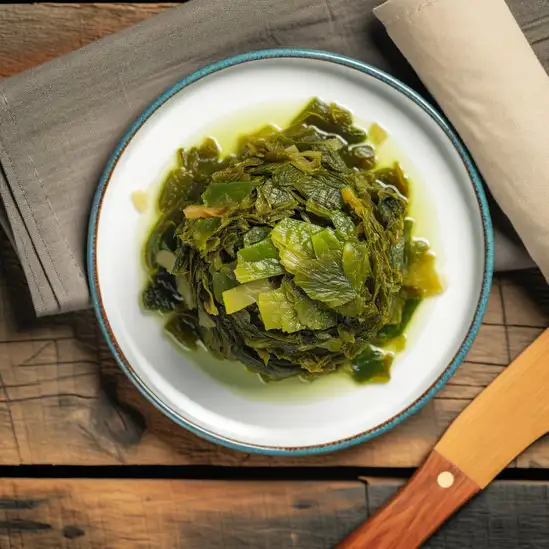



If you wander into Pātan,you’ll immediately feel like you’ve stepped into a living museum,but one that’s buzzing with life and warmth. The city hums with the gentle clatter of artisans carving intricate wooden windows and the soft murmur of locals chatting in the narrow,winding streets. There’s a timeless rhythm here,where centuries-old temples and courtyards stand shoulder to shoulder with vibrant markets spilling over with fresh spices,colorful fabrics,and the scent of incense mingling with the earthy aroma of freshly ground coffee. Walking through Pātan’s Durbar Square,your eyes feast on the delicate stone sculptures and the ornate pagoda roofs that seem to tell stories of a rich Newar heritage. The air is filled with the faint sound of bells and the occasional laughter of children playing nearby. If you pause at a small tea stall,you might catch the warm,spicy notes of masala chai blending with the sweet aroma of freshly baked sel roti,a local treat that’s as comforting as a hug. What makes Pātan truly special is its soul — a city where tradition and everyday life weave seamlessly together. The locals’ genuine smiles invite you to slow down and savor the moment,whether you’re watching a craftsman shape a bronze statue or sharing a meal of momos and dal bhat in a cozy courtyard. It’s a place that doesn’t just show you history; it lets you live it,breathe it,and carry a piece of it with you long after you leave.
The information on this page is currently being reviewed by Tripkliq and should be used as a guide only
Eng word: Hello
Eng pronunciation: Namaste
Local language: नमस्ते
Eng word: Goodbye
Eng pronunciation: Bidaai
Local language: विदाई
Eng word: Thank you
Eng pronunciation: Dhanyabad
Local language: धन्यवाद
Eng word: How much
Eng pronunciation: Kati
Local language: कति
Eng word: Toilet
Eng pronunciation: Shauchalaya
Local language: शौचालय
Eng word: Help me
Eng pronunciation: Malai maddat garnuhos
Local language: मलाई मद्दत गर्नुहोस्
Eng word: Yes
Eng pronunciation: Ho
Local language: हो
Eng word: No
Eng pronunciation: Hoin
Local language: होइन
Eng word: Excuse me
Eng pronunciation: Maaf garnuhos
Local language: माफ गर्नुहोस्
Pātan, also known as Lalitpur, is one of the oldest cities in Nepal, with its history dating back to the 3rd century BC. It is renowned for its rich cultural heritage and traditional Newari architecture.
Patan Durbar Square is a UNESCO World Heritage Site and a major attraction in Pātan. The square is home to numerous temples, palaces, and courtyards, showcasing the exquisite craftsmanship of the Newar artisans.
The Golden Temple, also known as Hiranya Varna Mahavihar, is a stunning 12th-century Buddhist monastery. It is famous for its golden facade and intricate carvings, making it a must-visit for tourists.
Krishna Mandir is a 17th-century Hindu temple located in Patan Durbar Square. Built by King Siddhi Narsingh Malla, it is an architectural marvel made entirely of stone and is dedicated to Lord Krishna.
The Patan Museum, housed in a former royal palace, offers a deep dive into the history and culture of the Kathmandu Valley. It features a vast collection of traditional Nepalese art and artifacts.
The Mahabouddha Temple, also known as the 'Temple of a Thousand Buddhas,' is a unique 14th-century structure covered with terracotta tiles, each depicting a Buddha image. It is a testament to the artistic prowess of the Newar craftsmen.
Rato Machhindranath Jatra is one of the oldest and most significant festivals celebrated in Pātan. The festival, dedicated to the rain god Rato Machhindranath, involves a grand chariot procession and attracts thousands of devotees.
Kumbheshwar Temple is one of the oldest and tallest temples in Pātan, dedicated to Lord Shiva. Built in the 14th century, it features a five-tiered pagoda and is a significant site for Hindu pilgrims.
Sundari Chowk is a beautiful courtyard within Patan Durbar Square, known for its intricate stone carvings and the Tusha Hiti, a sunken water tank adorned with exquisite sculptures.
In Pātan, the most common Power Adaptor is Type C, Type D, Type M.







A hearty noodle soup that originated from Tibet, typically made with meat or vegetables, and flavored with spices, making it a warming dish for colder days.

A traditional homemade, sweet, and crispy rice-based doughnut, often enjoyed during festivals and special occasions.

A traditional meal consisting of lentil soup (dal) served with rice (bhat) and accompanied by various side dishes like vegetables, pickles, and sometimes meat.

Nepalese dumplings filled with meat or vegetables, often served with a spicy dipping sauce. They are a popular street food in Pātan.

A unique curry made with potatoes (aloo) and bamboo shoots (tama), often cooked with black-eyed peas and spices.

Fermented leafy green vegetables, usually served as a side dish or in soups, providing a tangy flavor and rich nutrients.

Often referred to as 'Nepalese pizza', it is a rice crepe topped with various ingredients like minced meat, eggs, and vegetables.
The capital city of Maldives,Malé is a gateway to the country's world-famous islands and luxury resorts. Known for its pristine beaches,turquoise waters,and vibrant marine life,it's a top destination for relaxation and water activities.
ExploreBangkok is one of those cities that grabs you the moment you step out into its bustling streets. There’s this electric energy in the air—a mix of honking tuk-tuks,sizzling street food stalls,and the chatter of locals weaving through markets. The city feels alive,like it’s constantly moving and breathing,yet somehow it balances this chaos with moments of serene beauty,like the golden spires of temples catching the afternoon sun or quiet canals reflecting the sky.
Walking through Bangkok,you’ll be hit by a whirlwind of scents:fragrant jasmine from flower vendors,the sharp tang of lemongrass and chili from street carts,and the sweet aroma of mango sticky rice tempting you at every corner. The colors are just as vivid—neon signs flicker alongside traditional wooden shophouses,and monks in saffron robes glide past modern skyscrapers. It’s a city where old and new dance together effortlessly.
What really makes Bangkok special is its warmth and openness. The people here have a genuine kindness that shines through,whether you’re bargaining at Chatuchak Market or sharing a laugh over a bowl of spicy boat noodles. The culture is rich and layered,from the intricate rituals at Wat Pho to the lively festivals that light up the streets. Visiting Bangkok feels like stepping into a story that’s still unfolding,full of surprises and moments that stay with you long after you leave.
If you step into Colombo District,you immediately feel the pulse of a city that’s both vibrant and laid-back,where old-world charm meets modern hustle. Imagine walking along bustling streets lined with colonial-era buildings,their faded facades telling stories of a rich past,while sleek glass towers rise nearby,reflecting the tropical sun. The air carries a mix of scents—spices from street food stalls,salty sea breeze from the nearby coast,and the faint aroma of jasmine from roadside vendors. It’s a place where the sounds of honking tuk-tuks blend with the call to prayer and the laughter of children playing in small parks.
Colombo’s character is a beautiful mosaic of cultures. You’ll find Buddhist temples nestled beside mosques and churches,and markets where Tamil,Sinhalese,and Muslim communities come together in a colorful dance of languages and traditions. The city’s food scene is a feast for the senses—imagine biting into a crispy hopper drizzled with coconut sambol or sipping on a strong,sweet Ceylon tea while watching the sunset over Galle Face Green,where locals fly kites and families gather to unwind.
What makes Colombo truly special is its warmth. Despite the city’s fast pace,there’s a genuine friendliness in the smiles of shopkeepers and the inviting chatter in cafés. It’s a place where you can lose yourself in vibrant street art one moment and find quiet reflection in a serene temple garden the next. Colombo isn’t just a destination; it’s an experience that stays with you long after you leave.
Imagine stepping into a city where sleek skyscrapers meet lush greenery,and every corner hums with a vibrant energy that’s both modern and deeply rooted in tradition. That’s Singapore for you—a place where the air carries the fragrant mix of blooming orchids and sizzling street food,and the streets buzz with a blend of languages and laughter. Walking through neighborhoods like Chinatown or Little India,you’ll catch the rich aromas of spices mingling with the sweet scent of tropical fruits,inviting you to explore further.
What’s truly captivating about Singapore is how effortlessly it balances the fast-paced pulse of a global hub with pockets of serene beauty. You can be wandering through the futuristic Gardens by the Bay one moment,marveling at the towering Supertrees glowing softly at dusk,and the next,find yourself savoring a bowl of laksa or chili crab at a bustling hawker center,surrounded by locals chatting animatedly. The city’s character shines through its people—warm,diverse,and proud of their heritage,yet always welcoming.
There’s a rhythm here that’s both energizing and comforting. Whether you’re cycling along the waterfront,catching a sunset over Marina Bay Sands,or simply sipping kopi in a cozy café,Singapore invites you to slow down and soak in its unique blend of cultures,flavors,and sights. It’s a city that surprises you with its layers,making every visit feel like a new discovery.
Bali feels like stepping into a vibrant dream where every corner pulses with life and warmth. From the moment you arrive,there’s this unmistakable energy—part spiritual,part playful—that wraps around you like a soft,tropical breeze. Imagine waking up to the gentle rustle of palm leaves and the distant sound of waves crashing against volcanic black sand beaches. The air carries a mix of frangipani blossoms and salty sea spray,instantly grounding you in the island’s natural beauty.
What really makes Bali special is its rich culture woven into everyday life. You’ll see locals in colorful sarongs offering flowers at temple steps,hear the rhythmic beat of gamelan music drifting through the air,and catch glimpses of intricate wood carvings and vibrant paintings in small artisan shops. The island’s spirituality isn’t just something you observe—it’s something you feel,a quiet presence that invites you to slow down and connect.
And then there’s the food—oh,the food! Freshly grilled satay,fragrant nasi campur bursting with spices,and tropical fruits so sweet they almost taste like candy. Whether you’re dining in a bustling market or a cliffside café overlooking the ocean,every bite feels like a celebration of Bali’s rich flavors and traditions. Honestly,Bali isn’t just a place you visit; it’s a place that stays with you,long after you’ve left.
Imagine stepping into a place where the air hums with the gentle rhythm of waves lapping against sun-warmed shores,and the scent of salty sea mingles with fragrant street food stalls. That’s Phuket for you—a vibrant island that feels alive in every sense. It’s not just the stunning beaches that grab you,but the way the island pulses with a laid-back energy,where colorful markets buzz with chatter and the aroma of grilled seafood fills the air. Walking through the old town,you’ll find charming Sino-Portuguese buildings painted in pastel hues,their shutters creaking softly in the tropical breeze,while tuk-tuks zip by,adding a playful soundtrack to your explorations.
Phuket’s character is a beautiful blend of tradition and liveliness. Temples with golden spires peek out from lush greenery,inviting quiet moments of reflection,while nearby,night markets burst with life—vendors calling out,sizzling woks,and the sweet tang of mango sticky rice tempting your taste buds. The island’s culture is warm and welcoming,with locals who smile easily and share stories over cups of strong Thai coffee or fresh coconut water.
What makes Phuket truly special is how it wraps you in its embrace—whether you’re watching a fiery sunset from a cliffside bar,diving into crystal-clear waters teeming with vibrant marine life,or simply savoring the spicy kick of a freshly made curry. It’s a place that invites you to slow down,soak in the colors,sounds,and flavors,and leave with a heart full of unforgettable moments.
Unlicensed money exchangers offer attractive rates but shortchange tourists or provide counterfeit currency.
Scammers sell counterfeit tickets to Durbar Square or other heritage sites, which are not valid for entry.
Unlicensed individuals approach tourists claiming to be official guides and charge high fees for inaccurate or unnecessary information.
Unregistered agents sell fake or substandard trekking packages to tourists, often leaving them stranded or without proper services.
Restaurants near tourist attractions charge inflated prices for food and drinks, sometimes adding hidden charges to the bill.
Vendors in tourist-heavy areas inflate prices of handicrafts, statues, and other souvenirs, especially if they sense the buyer is unfamiliar with local pricing.
Crowded areas like Durbar Square are hotspots for pickpockets targeting distracted tourists.
Children or adults approach tourists with emotional stories to solicit money, often as part of organized begging rings.
Taxi drivers refuse to use meters and quote exorbitant prices for short distances, especially for tourists unfamiliar with local rates.
Scammers pose as temple caretakers or monks and pressure tourists into making 'mandatory' donations, which are not legitimate.
The use, possession, and trafficking of drugs are strictly prohibited in Nepal. The country has stringent laws against narcotics, and violations can result in severe penalties, including imprisonment. Tourists should avoid any involvement with illegal drugs to avoid legal complications.
In Pātan, Nepal, smoking is generally allowed in public places, but there are restrictions in certain areas such as government buildings, hospitals, and educational institutions. Tourists should be mindful of 'No Smoking' signs and avoid smoking in restricted areas to avoid fines.
Vaping is relatively new in Nepal, and there are no specific regulations that differentiate it from smoking. Therefore, the same rules that apply to smoking generally apply to vaping. Tourists should exercise caution and avoid vaping in non-smoking areas.
What are other people saying about Pātan?
Recent Social posts about Pātan
There is nothing to show you for now.